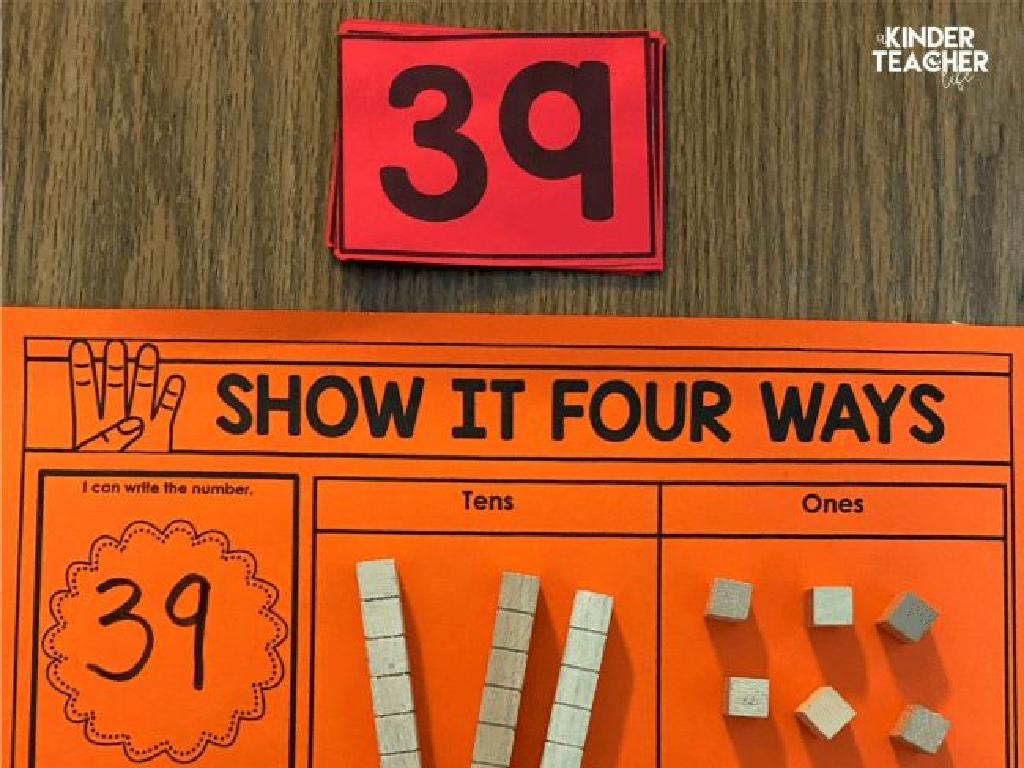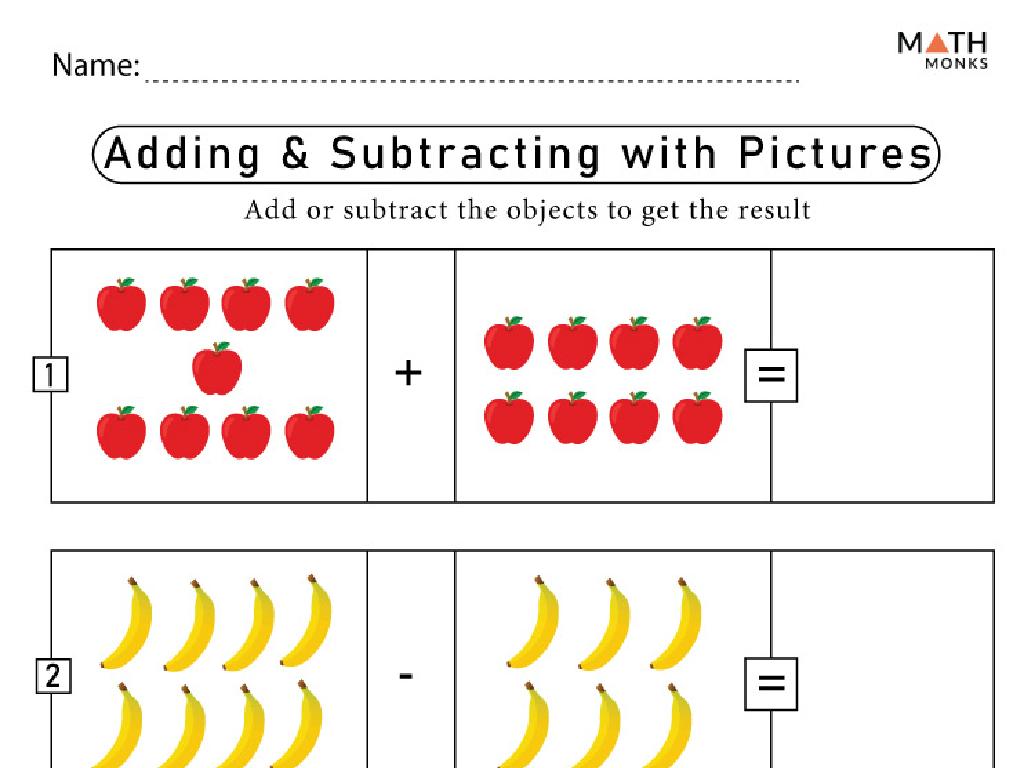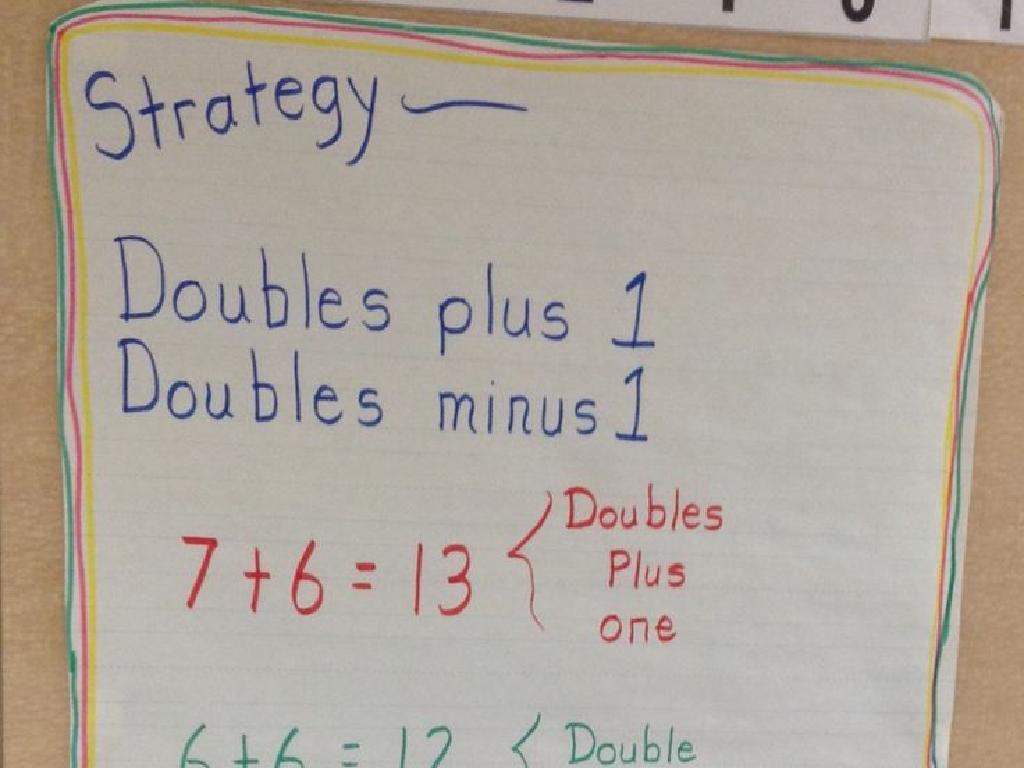Multiply 1-Digit Numbers By 3-Digit Or 4-Digit Numbers
Subject: Math
Grade: Fourth grade
Topic: Multiply By One-Digit Numbers
Please LOG IN to download the presentation. Access is available to registered users only.
View More Content
Mastering Multiplication: Large Numbers
– Multiplication as repeated addition
– If we have 4 groups of 3, that’s 3+3+3+3 or 4×3
– Review: Multiplying 1-digit numbers
– Let’s recall how to multiply numbers like 4×5
– Today’s goal: 1-digit x 3/4-digit numbers
– Learn to multiply numbers like 2×345 or 7×1234
– Practice makes perfect
|
Begin with the concept of multiplication as repeated addition to solidify the foundational understanding. Review multiplying smaller, 1-digit numbers as a warm-up and to build confidence. Introduce the day’s objective, which is to apply that understanding to multiply 1-digit numbers by larger numbers, specifically 3-digit and 4-digit numbers. Emphasize the importance of practice and provide several examples for the students to work through, such as 2×345 or 7×1234. Encourage students to use the methods they’ve learned to approach these larger problems and remind them that the steps are the same, regardless of the size of the numbers.
Multiplication Vocabulary
– What is a Multiplicand?
– The number we multiply, e.g., in 123 x 4, 123 is the multiplicand.
– Understanding the Multiplier
– The number that multiplies the other, e.g., in 123 x 4, 4 is the multiplier.
– Defining the Product
– The answer we get from multiplication, e.g., 123 x 4 gives a product of 492.
– Applying Vocabulary in Problems
|
This slide introduces the basic vocabulary of multiplication, which is essential for understanding and solving multiplication problems. The multiplicand is the number that is being multiplied. The multiplier is the number we are multiplying by. The product is the result of the multiplication. It’s important for students to familiarize themselves with these terms as they will be used frequently in math problems. To reinforce learning, have students identify the multiplicand, multiplier, and product in various multiplication examples. Encourage them to use these terms when they describe their process of solving multiplication problems.
Step-by-Step Multiplication
– Arrange the larger number on top
– Multiply by the single-digit number
– If 1234 x 3, multiply 4×3, 3×3, 2×3, then 1×3
– Place each product correctly
– Align products according to place value
– Carry over numbers when necessary
– E.g., 12 (from 4×3) write 2, carry 1
|
This slide guides students through the process of multiplying larger numbers by a single-digit number. Start by writing the larger number on top and the single-digit multiplier below it, ensuring that the digits are lined up correctly by place value. Multiply each digit of the larger number by the single-digit multiplier, starting from the rightmost digit. Write down the product of each multiplication under the corresponding digit, making sure to align them by their correct place value. If a product is greater than 9, remember to carry over the extra amount to the next highest place value. Practice this step-by-step method with several examples and ensure students understand the concept of carrying over.
Multiplying Large Numbers by 1-Digit
– Start with the ones place
– Multiply each digit by 4
– 4 x 6 (ones) = 24, write 4, carry 2
– Carry over when exceeding 9
– 4 x 2 (tens) + 2 (carry) = 10, write 0, carry 1
– Write down the final product
– 4 x 3 (hundreds) + 1 (carry) = 13, write down 1304 as the answer
|
This slide is aimed at teaching fourth graders how to multiply a 3-digit number by a 1-digit number. Begin by explaining the process of multiplication starting from the ones place, moving left towards the tens and hundreds. Emphasize the importance of carrying over to the next place value when the product of the multiplication exceeds 9. Use the example provided to walk through each step, ensuring to explain the carry over process. Have students practice with similar problems and check their understanding by asking them to explain the steps back to you.
Multiplication Practice: 7 x 1,532
– Multiply 7 by 1,532
– Write down each multiplication step
– Start with 7 x 2, then 7 x 30, 7 x 500, 7 x 1000
– Discuss steps with a classmate
– Explain your method to your partner
– Compare final answers together
– See if you both got 10,724 as the answer
|
This slide is aimed at providing students with a practical exercise to apply their multiplication skills. The problem involves a one-digit number (7) and a four-digit number (1,532), which will help students practice place value and the process of long multiplication. Students should write down each step to ensure they understand the multiplication process for each place value. After completing the problem individually, they will pair up with a classmate to discuss their methods and verify their answers. This peer interaction will reinforce their understanding and allow them to learn from each other. The teacher should circulate the room to assist and ensure that students are correctly applying the multiplication steps.
Common Mistakes in Multiplication
– Remember to carry over
– When a product exceeds 9, carry the extra value to the next place.
– Keep place values in order
– Each digit has a value based on its position.
– Align numbers correctly
– Write numbers one under the other, matching place values.
– Practice to avoid errors
|
This slide aims to highlight frequent errors students make while multiplying larger numbers. Emphasize the importance of carrying over when a product of multiplication is greater than 9, which is a common oversight. Stress the significance of place value, as mixing up can lead to incorrect results. Proper alignment of numbers is crucial for accurate calculations, especially when dealing with multi-digit numbers. Encourage students to double-check their work and practice regularly to minimize these mistakes. Provide examples and perhaps a short activity where students can correct deliberately flawed multiplication problems.
Let’s Multiply Together!
– Group multiplication on the board
– Volunteers solve 5 x 4,678
– One student writes each step on the board
– Discuss each step together
– Talk about carrying over numbers
– Understand the multiplication process
– Grasp why we multiply each digit by 5
|
This slide is designed to engage the class in a collaborative multiplication exercise. Start by inviting volunteers to come to the board to multiply 5 by 4,678. As they write out the problem, ensure that each step is discussed and understood by the whole class. Emphasize the importance of aligning the numbers correctly and carrying over when necessary. This exercise will help students visualize the multiplication process and understand the concept of multiplying each digit of the larger number by the one-digit number. Prepare to guide them through any mistakes and reinforce the learning with praise for effort. Have additional similar problems ready for students who grasp the concept quickly and need more challenge.
Multiplication Games: Practice and Fun!
– Engage in multiplication games
– Games make practicing multiplication exciting
– Challenge with varied numbers
– Try multiplying with 3-digit and 4-digit numbers
– Enjoy learning multiplication
– Games help learn while having a blast
– Share your high scores
|
This slide introduces a fun and interactive way to practice multiplication through games. Encourage students to play different multiplication games, which can help solidify their understanding of multiplying 1-digit numbers by 3-digit or 4-digit numbers. Challenge them to increase the difficulty by choosing larger numbers as they get more comfortable. Emphasize that learning can be enjoyable and that these games are a tool to make practice less tedious. Suggest that they keep track of their high scores to share with the class, fostering a friendly competitive spirit. Provide a list of recommended games suitable for fourth graders, and consider setting up a multiplication game day where students can play and learn together.
Class Activity: Multiplication Relay
– Split into teams and line up
– Each team receives a multiplication problem
– Solve a problem part on the board in turns
– Only one team member at a time can write the answer
– First team with correct solution wins!
|
This activity is designed to encourage teamwork and reinforce the concept of multiplying 1-digit numbers by 3-digit or 4-digit numbers. Before starting, ensure that each team understands the rules and the multiplication process. Provide each team with a different multiplication problem to ensure a fair challenge. As each student takes their turn, they should solve only one step of the multiplication process on the board. The next team member can continue from where the previous one left off. This relay continues until the entire problem is solved. The teacher should monitor the activity to ensure that each step is completed correctly. Possible variations of the activity could include using dice to generate random numbers for multiplication, timed relays for added excitement, or awarding points for teamwork and accuracy instead of speed.
Conclusion & Homework: Mastering Multiplication
– Excellent work on large number multiplication!
– Homework: Finish a 10-problem worksheet
– Worksheet focuses on multiplying 1-digit by 3 or 4-digit numbers
– Double-check your answers for accuracy
– Use estimation to verify if your answers are reasonable
– Practice makes perfect!
|
Today’s lesson was about multiplying 1-digit numbers by 3-digit or 4-digit numbers, and the students have done a great job. For homework, they are assigned a worksheet with 10 problems to reinforce what they’ve learned. Remind them to carefully check each problem for mistakes, perhaps by using estimation to see if their answers are in the right ballpark. This practice will help solidify their understanding and improve their accuracy. In the next class, we can review any common errors and celebrate their successes.






